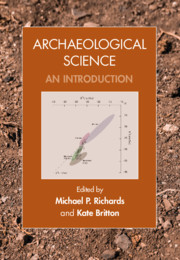Book contents
- Archaeological Science
- Archaeological Science
- Copyright page
- Contents
- Figures
- Tables
- Contributors
- Acknowledgements
- Part I Introduction
- Part II Biomolecular Archaeology
- 2 Ancient DNA
- 3 Proteomics
- 4 Residue Analysis
- 5 Isotope Analysis for Mobility and Climate Studies
- 6 Isotope Analysis for Diet Studies
- Part III Bioarchaeology
- Part IV Environmental Archaeology
- Part V Materials Analysis
- Part VI Absolute Dating Methods
- Index
- References
2 - Ancient DNA
from Part II - Biomolecular Archaeology
Published online by Cambridge University Press: 19 December 2019
- Archaeological Science
- Archaeological Science
- Copyright page
- Contents
- Figures
- Tables
- Contributors
- Acknowledgements
- Part I Introduction
- Part II Biomolecular Archaeology
- 2 Ancient DNA
- 3 Proteomics
- 4 Residue Analysis
- 5 Isotope Analysis for Mobility and Climate Studies
- 6 Isotope Analysis for Diet Studies
- Part III Bioarchaeology
- Part IV Environmental Archaeology
- Part V Materials Analysis
- Part VI Absolute Dating Methods
- Index
- References
Summary
Genetic sequences have traditionally been generated solely from modern individuals. Advances in laboratory and sequencing techniques, however, have made it possible to retrieve genetic information from fossil, archaeological, museum, or otherwise dead and degraded specimens. Genetic material derived from ancient specimens is referred to as ancient DNA (aDNA). The main advantage of ancient DNA is that it allows researchers to study past genetic diversity directly, rather than having to rely on modern genetic patterns to infer past population processes.
- Type
- Chapter
- Information
- Archaeological ScienceAn Introduction, pp. 13 - 34Publisher: Cambridge University PressPrint publication year: 2020



